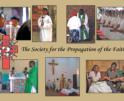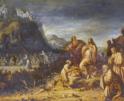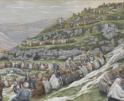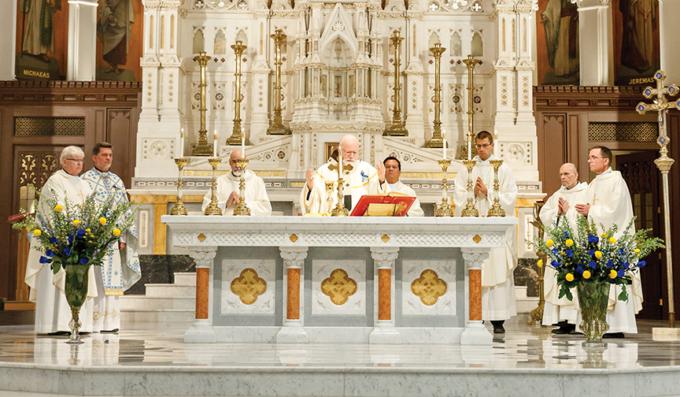
Faith

In another major move, the council fathers introduced eucharistic concelebration. This was somewhat of an innovation in that sacramental concelebration had hitherto been limited to priestly ordination.
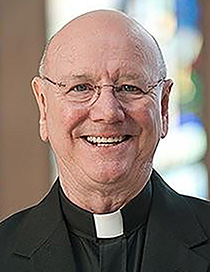
SJ
The second chapter of the constitution turns to the Eucharist in particular. This chapter reaffirms a number of the theological and pastoral principles set out in the first chapter, among them the richer use of Scripture (Sacrosanctum Concilium 51), a more readily understood connection between word and sacrament (SC 50), and simplifying parts of the rite that had become overgrown with added ceremonies over time (SC 50) -- all in order to foster more active participation. We can focus here on several specific issues, which move significantly beyond the pre-Vatican II Mass.
First, the homily is made mandatory (except when not possible) on Sundays and feast days of obligation. (SC 52) This emphasis on preaching couples nicely with the renewed emphasis on Scripture and the richer Lectionary that would result from the conciliar principles.
Second, the common prayer (or general intercessions or prayer of the faithful) were now restored with the expectation that the people take part in them. (SC 53) Except for the Good Friday Intercessions, they had disappeared from the Roman Rite Mass after the late fifth century. The General Instruction of the Roman Missal would later call these intercessions an exercise of the baptismal priesthood.
In another major move, the council fathers introduced eucharistic concelebration. This was somewhat of an innovation in that sacramental concelebration had hitherto been limited to priestly ordination. The reason given is to manifest "the unity of the priesthood." (SC 56) From the council debates, it is clear that part of the motivation for introducing concelebration was the desire to discourage the so-called private or solitary Mass. Permission was given for several occasions like Holy Thursday -- both the Mass of the Lord's Supper and the Chrism Mass; the blessing of an abbot; and bishops' meetings. The diocesan bishop was allowed to grant permission for concelebration at conventual Masses -- the daily Mass of a religious community.
In addition, SC "warmly recommends" that the people receive holy Communion from "the same sacrifice" that has been offered to ensure "a more perfect participation" in the Eucharist. (SC 55) Given the frequent pre-conciliar practice of distributing Communion independently of the priest's Communion and indeed the Communion rite itself, this change encouraged lay participants in the Eucharist to appreciate that this was indeed their offering as well as that of the priest. This is a practice that many parishes have been rather slow in adapting. People are often far more influenced by what they see than what they hear. Seeing Communion regularly distributed from hosts that have been reserved in the tabernacle diminishes people's appreciation that they are active participants in this event/action, which we call Eucharist. The Eucharist is an event before it is a sacred object.
The council fathers settled on a somewhat ambiguous formulation with regard to the very important issue of how the offering of the priest and people are related (SC 48). The Constitution of the Church (Lumen Gentium 10) refers to the role of the faithful in offering the eucharistic sacrifice in virtue of their common baptismal priesthood.
Finally, the constitution marks a striking advance over the Council of Trent on the issues of Communion from the cup. While maintaining Trent's insistence on concomitance (namely that the whole Christ, body and blood, is present in both the consecrated bread and the consecrated wine by reason of the consecration), SC allows that, under certain circumstances with the approval of the Apostolic See, Communion under both kinds might be given to the people. (SC 55) When taken together, all of these elements paved the way for an Order of Mass in the wake of the council that was remarkably different from the pre-conciliar liturgy.
Somewhat oddly, given the fact that the council was still in session, Pope St. Paul VI issued an encyclical letter, "Mysterium Fidei" in September 1965. There, he praised the liturgical reform undertaken by the council, but at the same time, expressed concerns about the dilution of eucharistic faith, especially with regard to transubstantiation and the sacrifice of the Mass. Such caution was to be characteristic of Pope St. Paul in the post-conciliar period. He also emphasized the four-fold presence of the Lord in the celebration of the Eucharist. He insisted that the presence of the Lord in the minister, in the proclamation of the Word, and in the assembled faithful is no less real than in the consecrated Body and Blood of Christ.
- Father John F. Baldovin, SJ, is professor of Historical and Liturgical Theology at Boston College School of Theology and Ministry.
Recent articles in the Faith & Family section
-
Did you know?Father Robert M. O'Grady
-
Sowing the Seeds of FaithMaureen Crowley Heil
-
Bread left overScott Hahn
-
Scripture Reflection for July 28, 2024, Seventeenth Sunday in Ordinary TimeJem Sullivan
-
What the universal call to holiness entailsDr. R. Jared Staudt


